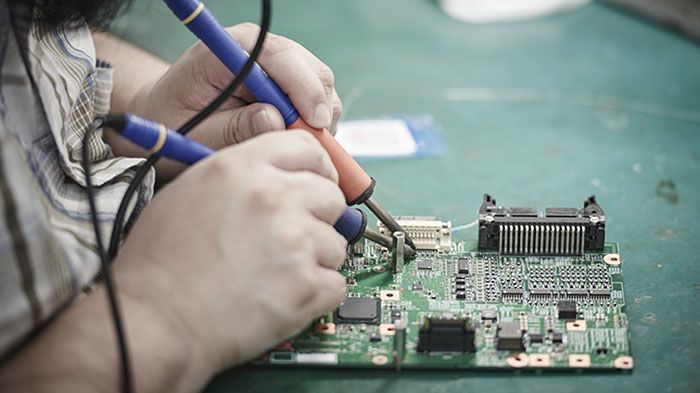Blog post -
World trends have finally caught up to manufacturing in Japan Development of an unprecedented product spurs IoT revolution
The adoption of the Internet of Things (IoT) has been growing, especially in manufacturing worldwide. This movement is spurring manufacturing innovation by connecting all kinds of objects, services, and information to a network.
At manufacturing sites in Japan, however, making improvements by collecting and analyzing data was already an established practice even before the term "IoT" became popular. These repeated improvement efforts have pushed "Japan Quality" to the position of a world-renowned brand.
For example, the production of semiconductors requires precise and detailed control of production status. Consequently, semiconductor manufacturers deal with huge amounts of data in numerous varieties, including temperature, pressure, and gas flow. In the production of automobiles, which is thought to have the most exacting demand for efficiency, huge volumes of data have been put to use so that parts can be replaced at the appropriate time in a well-planned manner before the breakdown of a machine occurs.
In fact, as far back as 10 or 20 years ago, there was already a need to acquire all kinds of data on the manufacturing floor. The desire to enhance production efficiency as well as the performance of products naturally grew among manufacturers. At the same time, they did not want to make the manufacturing system excessively complicated through the increased amounts of data handled.
The backdrop for these new demands was a changing manufacturing environment. As customer demands diversified, a more extensive lineup of products was required to meet these demands. This also made the lifespan of each product shorter, which in turn made it difficult for manufacturers to survive unless they released new products every year. The marketplace continued to globalize at an accelerated pace, and more and more factories were built close to the marketplace. Along with a shrinking labor force, there was a worldwide shortage of experienced workers, which made it difficult to transfer skills to later generations. For these reasons, the securing of workforce became a crucial issue for the manufacturing industry.
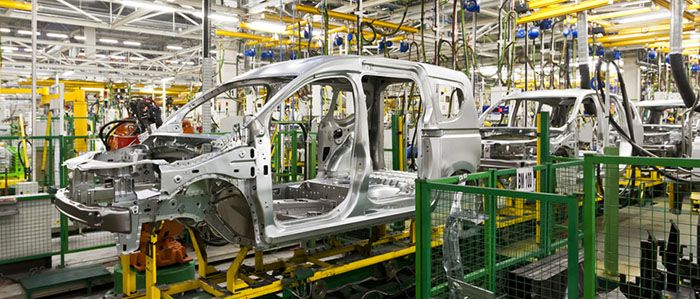
Automobile manufacturing line
What is required of manufacturing in order to quickly and accurately respond to changes in markets?
The conclusion that OMRON engineers had reached by delving into this question was the concept of an integrated controller that goes beyond the framework of a conventional controller. The new controller had to have an incredibly high processing speed and enable the integration of information and communication technology (ICT) with factory automation (FA).
An ultrahigh processing speed is required to exchange large amounts of data while operating a machine with high speed and precision. The exceptionally fast processing capability can add to controller performance, which in turn can make a complex system configuration simple enough to control via a single controller.
OMRON engineers were confident that this controller could breathe new life into data on the manufacturing floor that had not yet been put to use, and could serve as the heart of a system that could be effortlessly utilized by anyone, anywhere.
Even before the concepts of IoT and Industrie 4.0 became known to the world, OMRON had launched a project to develop the next-generation controller, the NX701.
The project team pursued not just a simple extension of the evolution that previously took place in the industry; rather it was an unprecedented world of control—control performed in one ten-thousandth of a second (100 microseconds). The team took on the challenge of realizing this overwhelming processing speed with the fastest Intel® Core TMi7 quad-core processor.
An unexplored world for developers
Although this may be hard to imagine for most people, a processor used for home-use PCs cannot be used directly for machine automation controllers used in factories. For example, a system freeze for 0.1 second would go unnoticed for most people and thus would not be a major problem for a home-use PC. But if the same thing happened at a factory, it could be a critical problem. The sudden stop of a machine can cause a malfunction and possibly lead to defective products.
Because of this, it was a common practice to use parts developed in-house specially for manufacturing applications. OMRON defied this conventional practice and decided to switch from its own processor to an Intel processor for its new product unveiled in 2011.
When this new development project was launched, nobody on the team could imagine that they would have to face a much more difficult challenge.
"A controller with a processing speed of 125 microseconds is four times as fast as our previous controller. To work stably on the manufacturing floor, we had to understand the behavior of the processor with an even faster speed—one millionth of a second," said Kenji Ogata, who was in charge of firmware. Another firmware developer, Shigeyuki Eguchi, added, "We tried to take full advantage of the multicore processor's characteristics. I believe it was a big challenge for Intel engineers as well, as we were stepping into an unexplored world. We worked together with Intel engineers while trying to convince them that this performance level was essential for manufacturing applications. Eventually, we were able to perfect the processor with specs that were durable enough to withstand use in the manufacturing environment."

Kenji Ogata (left) and Shigeyuki Eguchi (right) of the NX701 development team
Another important requirement for the commercialization of a new controller was downsizing. For an ultrahigh-speed controller with an Intel processor, people may imagine a big machine similar to a large-sized PC. But a huge controller is useless in the manufacturing environment. For efficiency-oriented manufacturing sites, effective space utilization of the equipment and factory floor is essential.
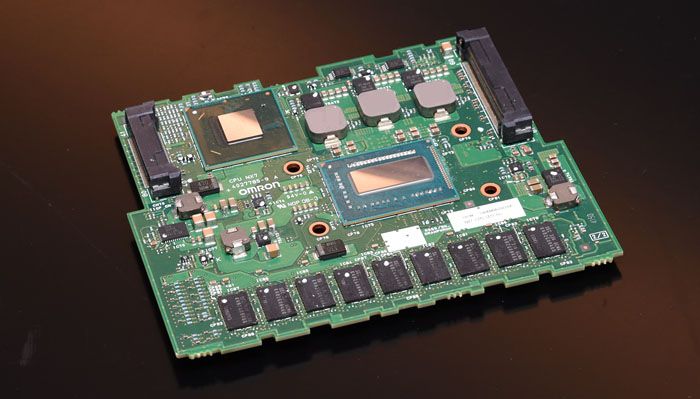
A part of the NX701 CPU unit
Katsuhiko Azuma, who was in charge of hardware, looked back on the challenge the team faced. "To make a controller that is compact enough to allow users of our conventional controller to use without major modification, a high-density circuit would be necessary, which causes heat buildup. As we've all experienced with a PC, overheating causes CPU operations to slow down," he says. "For the CPU to be applicable for manufacturing use, we had to guarantee reliable operation of the CPU at a maximum ambient temperature of 55°C to preserve the intended processing speed." To make this possible, the team exhaustively repeated thermal simulations and thoroughly pursued perfection in high-frequency circuit design technology. Ultimately, they were successful, Azuma proudly concludes. "In fact, our controller incorporates all of our knowhow. I doubt that anyone else could make a controller that works like this, even if they tried to make the same product based on our circuit diagram."
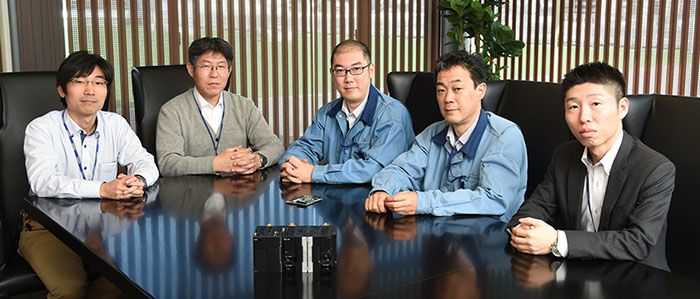
Members of the project team look back on the days of development
The merger of ICT and FA creates new harmonization between people and machines
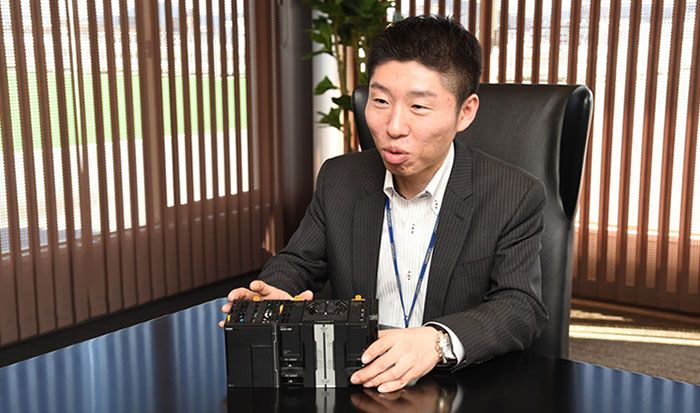
Tomoki Kurata, product manager
The NX701 is the industry's fastest controller, which the OMRON team completed by anticipating the needs of the future and overcoming all challenges. Released in April 2015, the controller has found its use in next-generation equipment for manufacturing major components of electrical vehicles and smartphones, both of which demand the utmost precision and safety, as well as maximum efficiency. It's simply overwhelming to see more than 40 machines operate perfectly in sync, maximizing productivity in these factories under the control of the NX701. Today it is even possible to keep track of the conditions in which each product is produced, and manage quality-related information of the preceding and succeeding steps, including causal connections.
In recent times, new manufacturing concepts such as IoT and Industrie 4.0 have also spread throughout Japan. The trends of the time have finally caught up to Japan's basic approach of manufacturing.
Product manager Tomoki Kurata encountered much skepticism from in-house people during the development of this controller. He answered their skepticism by steadily collecting the requirements of customers, then drawing up a vision of the ideal manufacturing environment of the future. Below, he talks about the development of this innovative controller.
"At that time, some people questioned whether this fast controller was really necessary. But I uphold OMRON's philosophy of 'To the machine, the work of the machine; to man, the thrill of further creation.'
There are also people who said that machines are simple replacements of people. Of course, machines can replace human operators in certain areas, completing tasks more quickly than human operators and without error, or working for long periods of time under hazardous conditions. But in the manufacturing floor we envision for the future, a machine can take the knowledge that human operators have accumulated and store it as data. It can then interpret the data and perform tasks as needed or even suggest possibilities for improvement. When I realized that this vision could suggest a solution for the issues our customers face today, I was certain that the NX701 would be the key product to create innovation for manufacturing.
Manifold increases in the speed of handling delicate operations will enable the high-speed production of things that were impossible to make before or even conceived of. Analyzing large amounts of data and providing feedback at high speed will lead to the visualization of manufacturing knowhow and artificial intelligence (AI). This will in turn advance the interaction between people and machines to much higher levels. We believe that the NX701 as the flagship model will pave the way for the future of manufacturing."
At OMRON, our goal is to bring innovation to manufacturing by combining the knowledge and technologies of other manufacturers with those of our own, in order to enrich the lives of people around the world.
We will continue challenging ourselves to create more intelligent machines and enable a new interaction between people and machines. In this way, machines will be able to unleash new human capabilities.
The NX701 Machine Automation Controller became a recipient of the Nikkei Business Daily Awards for Superiority in the 2015 Nikkei Superior Products and Services Awards organized by Nikkei Inc. According to the award judges, "As IoT and Big Data are being promoted by manufacturers, the significant improvements in processing speed and other performance qualities of the NX701 make it especially worthy because it can more flexibly meet these emerging needs." The NX701 was also recognized for its expected contribution to the spread of next-generation factories based on IoT and other advanced information and communication technologies.
YOU MIGHT ALSO LIKE
Topics
- Engineering industry
Categories
- manufacturing
- iot
- bigdata
- technologies
